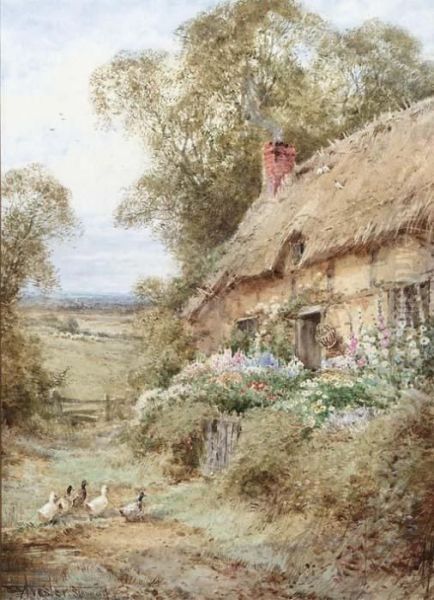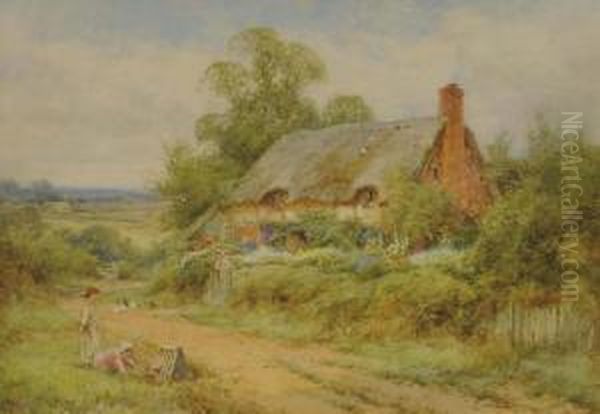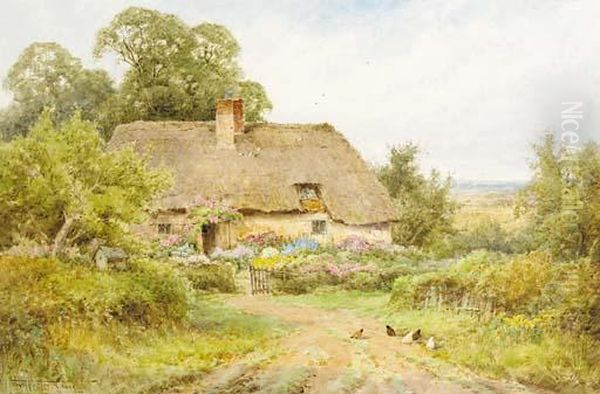Henry John Sylvester Stannard (1870-1951) stands as a significant figure in the tradition of English watercolour painting, celebrated for his idyllic and meticulously rendered depictions of the British countryside, particularly the rural charm of Bedfordshire. His work, deeply rooted in a love for pastoral scenery and the quiet dignity of country life, captured a vision of England that resonated with many during his lifetime and continues to evoke a sense of nostalgia and appreciation for a bygone era. Born into an established artistic family, Stannard not only inherited a predisposition for art but also cultivated his talents to become a respected member of the Royal Society of British Artists and a favourite of royal patrons, leaving behind a legacy of charming and technically proficient watercolours.
Early Life and Artistic Lineage
Henry John Sylvester Stannard was born in London in 1870, into a family already distinguished in the art world. His father was John Stannard (circa 1840s – 1909 or 1920, sources vary slightly on his death year), a notable landscape painter in his own right, and his grandfather was also an artist. This familial environment undoubtedly nurtured young Henry's artistic inclinations from an early age. The Stannard family had strong connections to Bedfordshire, and this region would become the primary muse for much of Henry's most characteristic work. Growing up surrounded by artistic practice and discussion provided him with an invaluable, informal education that complemented his later formal training.
The Stannard family was quite extensive in its artistic pursuits. Beyond his father, Henry's sister, Lilian Stannard (1877-1944), also became a well-regarded artist, known particularly for her beautiful and detailed paintings of gardens, often collaborating with Henry or exhibiting alongside him. Another sister, Theresa Sylvester Stannard (1898-1947), also pursued painting. This artistic dynasty, centered around Bedfordshire, contributed significantly to the local and national art scene, with Henry John Sylvester arguably becoming its most widely recognized member.
Education and Formative Influences

Recognizing his talent, Henry Stannard received formal art education to hone his skills. He studied at the prestigious South Kensington Art School (now the Royal College of Art) in London, a key institution for art training in Britain. His aptitude was evident early on; he reportedly gained his Art Teacher's Diploma at the remarkably young age of sixteen. This rigorous training provided him with a strong foundation in drawing and watercolour technique, which would become the hallmark of his mature style.
Further artistic development occurred at the National Art Training School, where he won a scholarship. His education instilled in him a respect for careful observation and detailed rendering, traits that are evident throughout his oeuvre. While the late 19th century saw the rise of Impressionism and Post-Impressionism across the Channel, and indeed influencing some British artists like Philip Wilson Steer or Walter Sickert, Stannard's work remained more aligned with the established traditions of English landscape watercolour painting, a lineage that includes masters like J.M.W. Turner (though Stannard's style was far more literal) and the detailed pastoralism of artists like Myles Birket Foster.
Artistic Style and Techniques
Henry Stannard's artistic style is characterized by its detailed realism, delicate touch, and evocative portrayal of light and atmosphere, primarily within the medium of watercolour. He was a master of traditional watercolour techniques, often combining them with precise pencil work to define forms and add texture. His palette was typically bright and naturalistic, capturing the varied greens of the English countryside, the warm tones of brick and thatch, and the soft hues of wildflowers.
A distinctive feature of his technique was the use of "bodycolour" (opaque watercolour, or gouache) for highlights, particularly white, to capture the sparkle of sunlight on water, the bloom of flowers, or the texture of a whitewashed cottage wall. He was also known to employ "scratching out," a technique where dry paint is carefully scraped away with a sharp tool to reveal the white paper underneath, creating fine highlights or suggesting textures like grasses or reflections. This meticulous approach resulted in works that were both charmingly picturesque and technically accomplished. His compositions are typically well-balanced, drawing the viewer into serene rural scenes.
Themes and Subjects: Celebrating Rural England

The predominant theme in Stannard's work is the English countryside, with a particular focus on Bedfordshire. He painted quintessential rural scenes: thatched cottages nestled in blooming gardens, tranquil village greens, farmyards bustling with poultry, quiet country lanes, and peaceful riverbanks. Figures, when they appear, are often engaged in everyday rural activities – a woman feeding chickens, children playing, or a farm labourer at rest. These figures are integral to the scene, enhancing the sense of lived-in, gentle domesticity rather than being the primary focus.
His paintings often celebrate the changing seasons, from the fresh blossoms of spring and the lush greenery of summer to the golden hues of autumn. Animals, especially ducks, chickens, and sometimes dogs or horses, are frequently featured, adding life and charm to his compositions. Works like A Country Cottage near Bedford with Ducks or A Bedfordshire Cottage with Chickens Feeding are exemplary of his favoured subjects. He captured an idealized, yet recognizable, vision of rural England, one that appealed to a public perhaps increasingly nostalgic for the perceived simplicity and beauty of country life in an era of industrialization and urbanization. This focus on idyllic rural life was shared by contemporaries such as Helen Allingham, whose charming depictions of Surrey cottages and gardens bear a thematic resemblance.
Representative Works
Several works stand out as representative of Henry Stannard's style and thematic concerns.
A Summer Day with Pets likely depicts a sun-drenched garden scene, perhaps with children and their animal companions, embodying the warmth and innocence he often sought to convey.
A Country Cottage near Bedford with Ducks is a title that immediately evokes his classic subject matter: a picturesque dwelling, probably with a thatched roof and climbing roses, a pond or stream nearby where ducks are foraging. Such scenes were his forte, showcasing his skill in rendering architecture, foliage, and animal life.
At Bromham in Bedford would be a specific location piece, capturing a particular view within this Bedfordshire village, known for its historic bridge and mill. Stannard often painted identifiable locations, grounding his idyllic visions in real places.
The Primrose Woods suggests a scene of early spring, with the woodland floor carpeted in primroses, a subject that would allow him to explore delicate colours and the gentle light filtering through trees.
Gathering Firewood would feature a figure, perhaps an elderly villager or a child, engaged in this timeless rural task, set against a backdrop of a woodland or a country lane, likely in autumn or winter.

These titles, and the many other similar works he produced, consistently point to his dedication to capturing the gentle, picturesque aspects of English rural existence. His paintings were not grand historical statements or avant-garde experiments but intimate, affectionate portrayals of a world he clearly loved.
Career, Recognition, and Royal Patronage
Henry Stannard achieved considerable success and recognition during his lifetime. He began exhibiting his work widely, and in 1896, he was elected a member of the Royal Society of British Artists (RBA), a significant honour that placed him among the established artists of his day. He also exhibited at other prestigious venues, including the Royal Academy in London, the Royal Institute of Painters in Water Colours, and various provincial galleries.
His charming depictions of the English countryside found favour with the public and critics alike, and notably, attracted royal attention. He received commissions from members of the British Royal Family, including Queen Alexandra (wife of King Edward VII) and later Queen Mary (wife of King George V), for whom he painted numerous views around their Sandringham Estate in Norfolk. This royal patronage significantly enhanced his reputation and the desirability of his work. Despite his national and international renown (his works were also sold in North America and other parts of the Empire), Stannard remained committed to his local art scene. He was a staunch supporter of the Bedfordshire Society of Artists and regularly participated in their exhibitions.
The Stannard Artistic Dynasty
Henry John Sylvester Stannard was not an isolated artistic talent but part of a broader family deeply involved in the arts. His father, John Stannard, as mentioned, was a landscape painter. His sister, Lilian Stannard (1877-1944), gained considerable acclaim for her watercolours of gardens, often exhibiting at the Royal Academy and the Society of Women Artists. Her style, while focused on cultivated floral beauty, shared a similar delicacy and attention to detail with her brother's work. They sometimes collaborated, and their works were often seen in similar exhibitions.
Another sister, Theresa Sylvester Stannard (1898-1947), also known as Mrs. E.A. Rimes, was a painter of flower subjects and landscapes, continuing the family tradition. Furthermore, Henry's nephew (Lilian's son), Henry John Skinner, also became an artist. This concentration of artistic talent within one family, particularly focused on landscape and floral subjects in watercolour, marks the Stannards as a notable, if perhaps less universally known, artistic dynasty compared to, say, the Pre-Raphaelite brotherhood or the Bloomsbury Group. Their collective output provides a rich visual record of the English countryside and gardens of their era.
Life in Flitwick and Community Involvement
In 1894, Henry Stannard moved to Flitwick, a village in Bedfordshire, where he would reside for much of his life. His home and studio there became a base for his artistic endeavours and his engagement with the local community. He was not a reclusive artist but an active participant in local life. His presence in Flitwick undoubtedly contributed to the cultural fabric of the area, and his home, "The Studio," likely became a point of interest.
Beyond his painting, Stannard was involved in art education and charitable activities. He served as a lecturer and judged art exhibitions, sharing his expertise and encouraging aspiring artists. He was known to donate his works to charitable causes. In his later years, he founded the Midland Sketching Club, fostering a community of artists in the region. His last exhibited work was reportedly shown at the club's annual exhibition in 1950, the year before his death. This commitment to local art initiatives demonstrates a generous spirit and a desire to nurture artistic talent beyond his own practice.
Stannard and His Contemporaries
Placing Henry Stannard within the context of his contemporaries reveals his position in the art world of the late 19th and early 20th centuries. While he was not an innovator in the modernist sense, like Roger Fry or members of the Camden Town Group such as Spencer Gore, he excelled within the established tradition of English watercolour landscape. His work can be seen alongside that of other artists who specialized in similar themes.
Helen Allingham (1848-1926) is perhaps one of the closest parallels, renowned for her charming watercolours of cottages and rural life in Surrey and Sussex. Both artists captured an idealized, picturesque vision of the English countryside that proved immensely popular. Myles Birket Foster (1825-1899), though of an earlier generation, had set a precedent for highly detailed and sentimental rural scenes in watercolour, and his influence can be detected.
In contrast, artists like George Clausen (1852-1944) or members of the Newlyn School, such as Stanhope Forbes (1857-1947) and Walter Langley (1852-1922), often depicted rural life with a greater degree of social realism, sometimes highlighting the hardships of agricultural labour, a dimension less apparent in Stannard's more consistently idyllic portrayals. However, all shared an interest in the lives and landscapes outside the bustling cities.
Other notable watercolourists of the period included Albert Goodwin (1845-1932), known for his atmospheric and often romantic landscapes, and Hercules Brabazon Brabazon (1821-1906), whose looser, more impressionistic style offered a contrast to Stannard's meticulous detail. The field of illustration also boasted remarkable watercolour talents like Arthur Rackham (1867-1939) and Edmund Dulac (1882-1953), whose imaginative works demonstrated the versatility of the medium, though their subject matter was fantastical rather than purely observational. Stannard's work, auctioned alongside artists like William Cruikshank (a Canadian painter of still life and rural scenes, though there were also British artists of the same name), indicates his place within the broader art market of the time.
Later Years and Enduring Legacy
Henry Stannard continued to paint and exhibit throughout his life, remaining dedicated to his chosen subjects and style. He passed away in 1951 in Bedford, leaving behind a substantial body of work that continues to be appreciated by collectors and enthusiasts of traditional English watercolour painting. His paintings are held in various public and private collections.
His legacy lies in his affectionate and skillful portrayal of a particular vision of England. In an era of rapid social and technological change, his art offered a comforting glimpse of pastoral tranquility and enduring rural traditions. While some might view his work as overly sentimental or nostalgic, its technical proficiency and genuine charm are undeniable. He captured the beauty of the everyday, the quiet corners of the countryside, and the simple pleasures of rural life with a sincerity that still resonates.
The enduring appeal of Stannard's work can also be attributed to its quintessential "Englishness." His paintings evoke a strong sense of place and a particular cultural identity associated with the English countryside. For many, his art represents a timeless vision of rural England, a peaceful and picturesque world that, even if idealized, holds a powerful attraction. His contribution, along with that of his artistic family members, enriches our understanding of regional British art and the enduring tradition of watercolour landscape painting.
Conclusion
Henry John Sylvester Stannard was a dedicated and talented artist who carved a distinct niche for himself within the British art scene of his time. As a master of watercolour, he meticulously documented the landscapes, cottages, and rural life of Bedfordshire and beyond, creating works that are both aesthetically pleasing and historically evocative. His success, marked by membership in the Royal Society of British Artists and royal patronage, attests to the quality and appeal of his art. While he may not have been at the forefront of modernist experimentation, his commitment to the pastoral tradition, his technical skill, and the sheer charm of his paintings ensure his lasting place as a beloved chronicler of the English countryside. His work continues to offer a window onto a gentler, more picturesque vision of England, preserving the beauty of its rural heritage for future generations to appreciate.